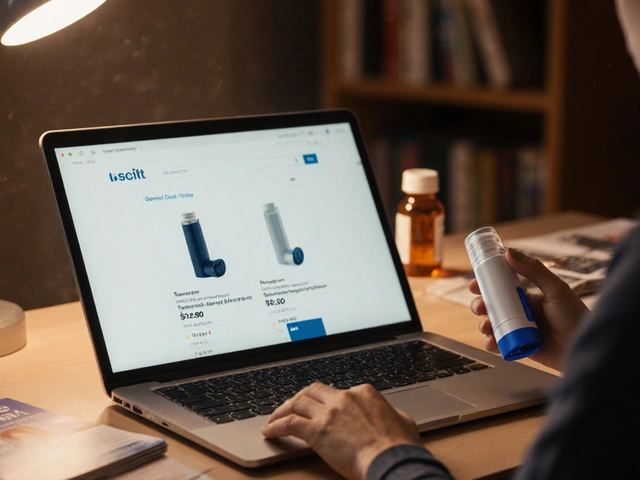Laxative Selection Tool
Find Your Ideal Laxative
Answer a few simple questions to get personalized recommendations based on the article's comparison of laxatives.
What's your primary need?
Any special health conditions?
Age group?
Recommended Laxative
Pros:
Cons:
When you’re dealing with occasional or chronic constipation, picking the right laxative can feel like a guessing game. Duphalac is the brand name for lactulose, an osmotic laxative that pulls water into the colon to soften stool and promote regular bowel movements. But it’s not the only option on the shelf. This guide walks you through how Duphalac stacks up against the most common alternatives, so you can decide which product fits your body, lifestyle, and health goals.
What Is Lactulose and How Does It Work?
Lactulose is a synthetic sugar made from galactose and fructose. When you swallow it, gut bacteria break it down into short‑chain fatty acids, creating an osmotic gradient that draws water into the intestine. The extra fluid softens the stool and speeds up transit. Because it works by changing the environment inside the colon, lactulose is considered an osmotic laxative, which generally causes fewer cramping episodes than stimulant laxatives.
Key Alternatives to Duphalac
Below are the five most widely used laxatives that people compare with lactulose. Each belongs to a different class, which means the way they act and their side‑effect profile can vary dramatically.
- Miralax (polyethylene glycol 3350) - an osmotic laxative that is often marketed as a gentle, powder‑mix drink.
- Senna - a stimulant laxative derived from the Senna plant that triggers bowel muscle contractions.
- Bisacodyl (brand names like Dulcolax) - a synthetic stimulant that works on the lower colon.
- Magnesium hydroxide (Milk of Magnesia) - an inorganic osmotic laxative that also acts as an antacid.
- Psyllium husk - a soluble fiber supplement that absorbs water to bulk up stool.
Quick Comparison Table
| Laxative | Class | Typical Onset | Common Dose | Pros | Cons |
|---|---|---|---|---|---|
| Duphalac (Lactulose) | Osmotic | 24‑48 hrs | 15‑30 ml (liquid) or 10‑20 g (powder) daily | Gentle, safe for long‑term use, also lowers blood ammonia in liver disease | Slower onset, possible gas/bloating |
| Miralax (PEG 3350) | Osmotic | 12‑24 hrs | 17 g (≈1 cap) mixed in 8 oz water daily | Fast, inexpensive, little taste | May cause electrolyte imbalance if overused |
| Senna | Stimulant | 6‑12 hrs | 0.5‑2 mg (tablet) 1‑2 times daily | Quick relief, works well for occasional constipation | Cramping, can lead to dependence |
| Bisacodyl | Stimulant | 6‑10 hrs | 5‑10 mg (tablet) nightly | Reliable, can be used as suppository for rapid effect | Abdominal pain, urgency |
| Magnesium hydroxide | Osmotic/Antacid | 30‑60 mins | 5‑15 ml (liquid) or 0.5‑2 tsp (powder) daily | Fast acting, also relieves heartburn | Can cause hypermagnesemia in kidney disease |
| Psyllium husk | Fiber supplement | 12‑24 hrs | 1‑2 tbsp mixed with water 1‑2 times daily | Improves stool bulk, good for overall gut health | May cause bloating if not enough water |

When to Choose Duphalac Over the Rest
Duphalac shines in a few specific scenarios:
- Long‑term management: Because it’s gentle, doctors often prescribe lactulose for chronic constipation or for patients with hepatic encephalopathy, where daily use is required.
- Children and elderly: The low‑dose liquid form is easy to swallow, and the slower onset reduces the risk of sudden diarrhea.
- Concurrent liver issues: Lactulose lowers ammonia levels, offering a dual benefit for people with cirrhoses.
If you need quick relief for a one‑off episode, a stimulant like Senna or a fast‑acting osmotic such as magnesium hydroxide might be more appropriate.
Potential Side Effects and Safety Tips
All laxatives carry some risk. Here’s what to watch for with each option.
- Duphalac (Lactulose): Gas, bloating, mild cramping. Start with a half dose and increase gradually.
- Miralax (PEG 3350): Rare electrolyte shifts; stay hydrated.
- Senna: Hard cramps and urgency; limit use to no more than two weeks to avoid dependence.
- Bisacodyl: Sharp abdominal pain; avoid if you have inflammatory bowel disease.
- Magnesium hydroxide: Can raise magnesium levels, especially if you have kidney problems.
- Psyllium husk: Needs plenty of fluid; otherwise, it may cause blockage.
How to Switch Safely Between Laxatives
If you decide to move from Duphalac to another product, follow these steps to avoid rebound constipation:
- Gradually taper the lactulose dose over 3‑5 days.
- Introduce the new laxative at a low dose while the lactulose tapers.
- Monitor stool consistency daily; adjust the new product as needed.
- Stay hydrated and maintain a diet rich in fiber (fruits, vegetables, whole grains).
- Consult your pharmacist or GP if symptoms persist beyond a week.

Cost and Availability - What to Expect in 2025
Pricing can influence your choice, especially if you need a long‑term solution.
- Duphalac: In New Zealand, a 500 ml bottle costs around NZ$15, and a 1 kg powder is about NZ$30.
- Miralax: Typically sold in 425 g packs for NZ$25.
- Senna and Bisacodyl: Over‑the‑counter tablets range NZ$5‑10 per pack.
- Magnesium hydroxide: Liquid 200 ml bottles are about NZ$8.
- Psyllium husk: Bulk 500 g packages are roughly NZ$12.
Insurance schemes in the public health system often cover Duphalac for liver patients, but not always for simple constipation, so check your benefits.
Bottom Line - Which Laxative Wins?
There’s no one‑size‑fits‑all answer. If you need a gentle, long‑term solution and you have liver concerns, Duphalac probably remains the top pick. For rapid relief or occasional use, an over‑the‑counter stimulant or magnesium‑based product may suit you better. And if you prefer a cost‑effective daily routine without a prescription, Miralax and psyllium husk are solid contenders.
Frequently Asked Questions
What is the main difference between Duphalac and Miralax?
Duphalac (lactulose) is a synthetic disaccharide that works by altering gut bacteria, while Miralax (PEG 3350) is an inert polymer that pulls water directly into the colon. Lactulose tends to act slower but is also used to lower blood ammonia, a benefit Miralax doesn’t provide.
Can I use Duphalac if I’m pregnant?
Lactulose is classified as Category B by the FDA, meaning animal studies show no risk and there are no well‑controlled studies in pregnant women. Doctors often consider it safe for mild constipation during pregnancy, but you should always check with your obstetrician before starting.
How long should I stay on Duphalac?
For chronic constipation, many clinicians recommend a trial of 4‑6 weeks. If symptoms improve, the dose can be reduced to the lowest effective amount. For hepatic encephalopathy, treatment often continues indefinitely under medical supervision.
Why does Duphalac cause gas?
Lactulose is fermented by colonic bacteria, producing hydrogen, methane, and carbon dioxide. This fermentation process softens stool but also releases gas, leading to bloating in some users.
Is it safe to mix Duphalac with other laxatives?
Combining two osmotic agents (like lactulose and magnesium hydroxide) can increase the risk of diarrhea and electrolyte loss. If you need stronger relief, switch rather than stack, and always talk to a pharmacist first.






Comments
Ben Durham
October 26, 2025 AT 18:23 PMDuphalac works well for people who need a gentle, long‑term solution. Its osmotic action is slower, which can be an advantage if you want to avoid sudden diarrhea. The fact that it also helps lower ammonia makes it a unique choice for patients with liver issues.
Joy Dua
October 31, 2025 AT 09:30 AMThe comparative tableau illustrates that Duphalac, while philosophically elegant, lags in immediacy. Its bacterial fermentation yields gas, an epiphenomenon many find disagreeable. Yet the dual therapeutic vector of ammonia reduction cannot be dismissed lightly.
Holly Kress
November 5, 2025 AT 00:37 AMFor anyone weighing options, consider both the timeline and the side‑effect profile. If you’re managing chronic constipation, the steady, gentle pull of lactulose is often preferable. Conversely, an occasional flare may justify a rapid‑acting stimulant.
Chris L
November 8, 2025 AT 11:57 AMI agree with the gentle‑onset point; I’ve seen patients maintain stable bowel habits on a low‑dose regimen. It’s especially useful when the goal is to avoid the “boom‑boom” effect of stimulants.
Leah Ackerson
November 11, 2025 AT 23:17 PM🧐 The metaphysical dance between bacteria and sugar is fascinating, yet the inevitable flatulence feels like a minor cosmic joke. 🙃 Still, when liver health is at stake, the trade‑off becomes philosophically justifiable.
Gary Campbell
November 15, 2025 AT 10:37 AMWhat they don’t tell you is that the water‑pulling mechanism of lactulose could be a covert agenda of Big Pharma to keep us dependent. The same entities push PEG‑based products as “inert” while hiding long‑term microbiome impacts. Stay skeptical.
Barbara Ventura
November 17, 2025 AT 18:10 PMIndeed, the narrative is complex, and the data, while extensive, is often filtered through corporate lenses, leading to selective dissemination, which, in turn, perpetuates a cycle of consumer reliance on pharmaceutical osmotics, rather than encouraging dietary fiber solutions, which could mitigate dependence.
Barna Buxbaum
November 20, 2025 AT 01:43 AMIf you’re new to the world of laxatives, start by assessing your lifestyle. A balanced diet with adequate hydration often reduces the need for any medication. When you do need a product, match its onset time and side‑effects to your personal schedule.
Alisha Cervone
November 21, 2025 AT 05:30 AMJust pick one and stick with it.
asha aurell
November 22, 2025 AT 09:17 AMDuphalac is slow but reliable; stimulants are fast but harsh.
Carolyn Cameron
November 24, 2025 AT 16:50 PMThe discourse surrounding lactulose, marketed as Duphalac, merits a scrupulous examination that traverses pharmacodynamics, patient compliance, and socioeconomic considerations. Firstly, the osmotic nature of lactulose engenders a gradual influx of water into the colonic lumen, thereby facilitating stool softening without precipitating abrupt colonic hypermotility. Secondly, the metabolic conversion of lactulose by resident colonic flora yields short‑chain fatty acids, a process that concurrently diminishes systemic ammonia concentrations-a salient advantage for individuals afflicted with hepatic encephalopathy. Thirdly, the temporal latency of 24 to 48 hours before clinical effect manifests may be construed as a limitation for acute symptomatology, yet it confers a therapeutic steadiness conducive to chronic management. Fourthly, the safety profile of lactulose is commendable, with adverse events largely confined to transient bloating and flatulence, phenomena that are generally well tolerated. Fifthly, comparative cost analyses in the Australasian market reveal that Duphalac, while not the least expensive option, remains competitively priced relative to polymeric osmotics such as polyethylene glycol. Sixthly, insurance reimbursement schemes frequently prioritize lactulose for hepatic indications, thereby attenuating out‑of‑pocket expenditures for a subset of patients. Seventhly, the palatability of the liquid formulation may influence adherence, particularly among pediatric and geriatric cohorts, necessitating consideration of dosage flexibility. Eighthly, the potential for drug‑drug interactions remains minimal, distinguishing lactulose from stimulant laxatives that may precipitate electrolyte imbalances. Ninthly, the broader implications for gut microbiota composition warrant ongoing investigation, as chronic osmotic loading could theoretically modulate microbial diversity. Tenthly, patient education on gradual dose titration emerges as a pivotal factor in mitigating gastrointestinal discomfort. Eleventhly, the existence of generic lactulose formulations expands accessibility across varied healthcare settings. Twelfthly, clinicians must remain vigilant for rare cases of overtreatment leading to diarrhea, which could compromise nutritional status. Thirteenthly, the integration of lactulose within a multimodal constipation regimen, synergized with dietary fiber enrichment, may enhance overall bowel health. Fourteenthly, systematic reviews consistently endorse the efficacy of lactulose for chronic constipation, underscoring its status as a first‑line therapeutic agent. Fifteenthly, future research should elucidate the comparative long‑term outcomes of lactulose versus newer osmotic agents. In summation, Duphalac occupies a distinctive niche wherein its pharmacological attributes, safety margin, and ancillary hepatic benefits converge to render it a judicious choice for sustained constipation management.
sarah basarya
November 25, 2025 AT 20:37 PMWow, that's a textbook‑level deep dive! Honestly, most of us just want a bathroom without waiting days. Still, kudos for the exhaustive breakdown-it’s like reading a novel about stool.
Samantha Taylor
November 28, 2025 AT 04:10 AMOh, please, the “dual benefit” narrative is just a marketing gimmick. If you wanted to lower ammonia, you’d just take a proper liver medication, not sugar water. And the so‑called gentle onset is just a fancy way of saying “it takes forever.”
Joe Langner
November 29, 2025 AT 07:57 AMI think the point is that some peopole need a slow options, not everybodys gonna want a quick fix. Also, the sugar algo helps bacteria addtionally. This could be a good fit for some.
Ben Dover
December 1, 2025 AT 15:30 PMWhile the aforementioned commentary attempts a veneer of objectivity, it neglects the salient fact that incremental osmotic therapies perpetuate a reliance on pharmaceutical intermediaries, thereby marginalizing dietary interventions.